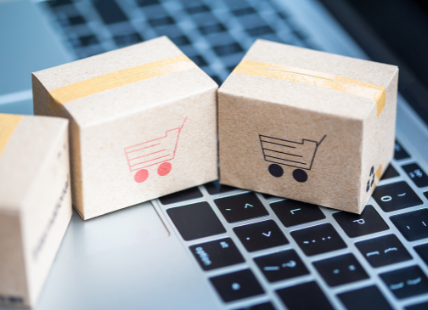
How is Ecommerce Changing Logistics?

Ecommerce has changed how we shop as individuals, how businesses make purchases and who retailers are competing with. The dawn of ecommerce has affected many aspects of our day-to-day lives, from how we work, to how we complete errands, and spend our valuable time. The growth of ecommerce has not only impacted retailers, buyers and consumers, but everyone involved in the logistics industry – including warehouse managers and last mile truck drivers, as well as all business owners relying on logistics teams to move their product.
Statista projects revenue from ecommerce in the USA to reach 469,245 billion dollars this year, and 563.4 billion dollars by 2025. Investing in ecommerce is key, and an awareness of how it affects logistics can help you make advantageous decisions for your business.
Here we look into the growth of ecommerce, and answer an essential question: how is ecommerce changing logistics? Learn more and find out what steps you can take for business success.
When Did Ecommerce Begin?
It has been clear for a long time that ecommerce is the way of the future. The very first online purchase was made in 1994. Over the past decades, countless brick and mortar stores have closed and online stores and marketplaces like Amazon have risen to become the giants they are today.
Is Ecommerce the Future of Business?
The pandemic has also encouraged change in this direction. Those that previously chose to browse their local stores discovered the convenience of online shopping, and although many consumers are keen to get back out there and support their local stores, others will continue their new habits.
Ecommerce isn’t going anywhere. Successful business leaders will embrace the change, look to the future and compete by continuing to optimize their online presence, logistics and supply chain to enable seamless ecommerce processes. So, is ecommerce the future of business? Yes.
How Does Ecommerce Logistics Work?
Logistics might not be the first thing you think of when you consider how ecommerce is affecting retailers. However, good logistics processes are some of the most important factors that will determine which retailers are able to adapt and survive.
Ecommerce logistics includes the process of buying materials and supplies, moving stock, warehousing, delivering internationally, across the country, and through the last mile. It includes product returns, securing the most efficient and affordable transportation, and planning for seasonal demand. The best way to make ecommerce logistics work is by partnering with a 3PL who can optimize and manage your logistics processes, from start to finish.
How is Ecommerce Changing Logistics Processes for Retailers?
Logistics has a huge impact on ecommerce retailers’ success. Below, we highlight a few key areas in which ecommerce is changing the logistics process for retailers, and how you can optimize these areas for maximum results.
Free and Fast Shipping
According to Oberlo, free delivery is the primary reason customers choose to shop online. Be sure you can deliver to customer’s expectations – shipping should not only be free, but fast.
International, National and Local Delivery
Ecommerce can empower smaller stores to reach customers far and wide, who may not have heard of their brand otherwise. This creates a need for dependable transportation services to ensure products safely and efficiently reach customers locally, nationally and internationally. Choose a 3PL with teams across the nation, and experience with every step in the shipping process, including first mile and last mile delivery.
Reverse Logistics
Ecommerce does have its limitations, in terms of enabling customers to gain an accurate understanding of the product they are choosing to purchase. Images can be misleading; size and color may not be as expected and it can be difficult to assess quality when purchasing online. Returning a purchase via free shipping may also seem like a more appealing and easier option than walking into a store and requesting a refund. All these factors may increase the likelihood that a customer returns the product they purchased.
A good logistics team can help you manage returns. Ensure you have a strong reverse logistics process in place, to help you identify problem product lines, increase efficiency and minimize returns and profit loss.
Warehousing
Access to warehousing across the country is more important than ever:
- Having use of multiple warehouses near major cities makes it easier to get products to customers quickly.
- Access to warehousing is necessary to keep a wide range of products in-stock at all times, to facilitate next-day delivery.
Warehousing is in strong demand, as increasing numbers of retailers move towards ecommerce and need a wider reach to serve long-distance customers. Working with a 3PL can help smaller and mid-size businesses without their own warehouse facilities keep up with larger competitors. Consider this: would investing in a stronger strategy be more affordable and future-proof than paying for expedited delivery on every order?
Technology and Reporting
New technology isn’t only there to help consumers and increase their expectations – ecommerce platforms often come with helpful reporting tools that can help you make wiser purchasing decisions. A good 3PL will also use technology to optimize every aspect of your supply chain to save you time and money.
Work With a 3PL for Proven Success
Beltmann Integrated Logistics has expert knowledge of ecommerce logistics to help you embrace change and improve processes.
Contact us today for more information on how our transportation and warehousing services can help you meet your business goals.
What Does White Glove Delivery Include? White glove delivery includes a far more comprehensive list of services than that of standard delivery. White glove delivery service may include: A scheduled delivery appointment, for delivery to arrive within a window of time. Delivery of the shipped item to the residence/business location and room or your choice. Unpacking of shipped items. Unwrapping and disposal of packaging. Movement of items up or downstairs. Assembly of funiture. Set up or installation of equipment.






